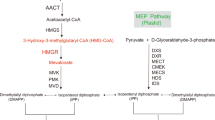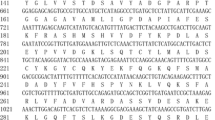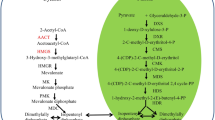Abstract
Ginkgo biloba, an industrial plant of high medicinal value, is resistant to pest, disease infections, and environmental stresses. 3-Hydroxy-3-methylglutaryl-coenzyme A synthase (HMGS) is a key mevalonic acid pathway enzyme that plays crucial roles in plant defense mechanism. In the present study, a 1407-bp HMGS gene, GbHMGS2, encoding 468 amino acid residues was cloned from G. biloba. A promoter sequence (1479-bp long) of the gene was screened from G. biloba genome data. The promoter contained the putative light-responsive (Box 4, G-Box, GT1-motif, I-box, and Sp1), cold-responsive (LTR), hormone-responsive (auxin and methyl jasmonate), and defense-related (W-box and MBS) regulatory elements. Putative GbHMGS2 protein shared high similarities to other plant HMGSs containing the conserved motif and all conserved active sites possessed by the plant HMGS protein family. Functional complementation of GbHMGS2 in an hmgs-deficient Saccharomyces cerevisiae strain confirmed the catalytic activity of GbHMGS2 protein. GbHMGS2 was preferentially expressed in the roots of G. biloba among the plant organs. The GbHMGS2 transcription was upregulated in response to cold, dark, methyl jasmonate, salicylic acid, and abscisic acid treatments, in agreement with the regulatory elements predicted in promoter region. The present work on GbHMGS2 could help ensuing research on its function, especially in the signal transduction pathways in G. biloba.







Similar content being viewed by others
References
Abe H, Urao T, Ito T et al (2003) Arabidopsis AtMYC2 (bHLH) and AtMYB2 (MYB) function as transcriptional activators in abscisic acid signaling. Plant Cell 15:63–78
Almasia NI, Narhirñak V, Hopp HE et al (2010) Isolation and characterization of the tissue and development-specific potato snakin-1 promoter inducible by temperature and wounding. Electron J Biotechn 13:8–9
Aoyagi K, Beyou A, Moon K et al (1993) Isolation and characterization of cDNAs encoding wheat 3-hydroxy-3-methylglutaryl coenzyme A reductase. Plant Physiol 102:623–628
Argout X, Fouet O, Wincker P et al (2008) Towards the understanding of the cocoa transcriptome: production and analysis of an exhaustive dataset of ESTs of Theobroma cacao L. generated from various tissues and under various conditions. BMC Genom 9:512
Bari R, Jones JG (2009) Role of plant hormones in plant defence responses. Plant Mol Biol 69:473–488
Campobasso N, Patel M, Wilding IE et al (2004) Staphylococcus aureus 3-hydroxy-3-methylglutaryl-CoA synthase: crystal structure and mechanism. J Biol Chem 279:44883–44888
Chang J, Ning Y, Xu F et al (2015) Research advance of 3-hydroxy-3-methylglutaryl-coenzyme a synthase in plant isoprenoid biosynthesis. J Anim Plant Sci 25:1441–1450
Cheng H, Li L, Cheng S et al (2013a) Molecular cloning and characterization of three genes encoding dihydroflavonol-4-reductase from ginkgo biloba in anthocyanin biosynthetic pathway. PLoS ONE 8:e72017
Cheng H, Li L, Xu F et al (2013b) Expression patterns of a cinnamyl alcohol dehydrogenase gene involved in lignin biosynthesis and environmental stress in ginkgo biloba. Mol Biol Rep 40:707–721
Cheng S, Wang X, Xu F et al (2016) Cloning, expression profiling and functional analysis of CnHMGS, a gene encoding 3-hydroxy-3-methylglutaryl coenzyme a synthase from chamaemelum nobile. Molecules 21:316
Choi D, Bostock RM, Avdiushko S et al (1994) Lipid-derived signals that discriminate wound-and pathogen-responsive isoprenoid pathways in plants: methyl jasmonate and the fungal elicitor arachidonic acid induce different 3-hydroxy-3-methylglutaryl-coenzyme A reductase genes and antimicrobial isoprenoids in Solanum tuberosum L. Proc Natl Acad Sci USA 91:2329–2333
Cutler SR, Rodriguez PL, Finkelstein RR et al (2010) Abscisic acid: emergence of a core signaling network. Annu Rev Plant Biol 61:651–679
Diamond BJ, Bailey MR (2013) Ginkgo biloba: indications, mechanisms, and safety. Psychiatr Clin N Am 36:73–83
Dunn MA, White AJ, Vural S et al (1998) Identification of promoter elements in a low-temperature-responsive gene (blt4.9) from barley (Hordeum vulgare L.). Plant Mol Biol 38:551–564
Edwards D, Murray JAH, Smith AG (1998) Multiple genes encoding the conserved CCAAT-Box transcription factor complex are expressed in Arabidopsis. Plant Physiol 117:1015–1022
Eulgem T, Rushton PJ, Robatzek S et al (2000) The WRKY superfamily of plant transcription factors. Trends Plant Sci 5:199–206
Eyidogan F, Oz MT, Yucel M et al (2012) Signal transduction of phytohormones under abiotic stresses. In: Khan NA, Nazar R, Iqbal N, Anjum N (eds) Phytohormones and abiotic stress tolerance in plants. Springer, Berlin, pp 1–48
Fujita Y, Fujita M, Shinozaki K et al (2011) ABA-mediated transcriptional regulation in response to osmotic stress in plants. J Plant Res 124:509–525
Gaffney T, Friedrich L, Vernooij B et al (1993) Requirement of salicylic acid for the induction of systemic acquired resistance. Science 261:754–756
Gao S, Lin J, Liu X et al (2006) Molecular cloning, characterization and functional analysis of a 2C-methyl-d-erythritol 2, 4-cyclodiphosphate synthase gene from Ginkgo biloba. J Biochem Mol Biol 39:502–510
Guan R, Zhao Y, Zhang H et al (2016) Draft genome of the living fossil Ginkgo biloba. Gigascience 5:49
Hemmerlin A, Hoeffler JF, Meyer O et al (2003) Cross-talk between the cytosolic mevalonate and the plastidial alonate and the plastidial methylerythritol phosphate pathways in tobacco bright yellow-2 cells. J Biol Chem 278:26666–26676
Heyworth CJ, Iason GR, Temperton V et al (1998) The effect of elevated CO2 concentration and nutrient supply on carbon-based plant secondary metabolites in Pinus sylvestris L. Oecologia 115:344–350
Joshi CP (1987) An inspection of the domain between putative TATA box and translation start site in 79 plant genes. Nucleic Acids Res 15:6643–6653
Kai G, Miao Z, Zhang L et al (2006) Molecular cloning and expression analyses of a new gene encoding 3-hydroxy-3-methylglutaryl-coa synthase from Taxus × media. Biol Plantarum 50:359–366
Kai GY, Li SS, Wang W et al (2013) Molecular cloning and expression analysis of a gene encoding 3-hydroxy-3-methylglutaryl-coa synthase from Camptotheca acuminata. Russ J Plant Physl 60:131–138
Kang MK, Nargis S, Kim SM et al (2013) Distinct expression patterns of two Ginkgo biloba, 1-hydroxy-2-methyl-2-(E)-butenyl-4-diphosphate reductase/isopentenyl diphosphate synthase (HDR/IDS) promoters in Arabidopsis model. Plant Physiol Bioch 62:47–53
Kawoosa T, Singh H, Kumar A et al (2010) Light and temperature regulated terpene biosynthesis: hepatoprotective monoterpene picroside accumulation in Picrorhiza kurrooa. Funct Integr Genomic 10:393–404
Kim SM, Kim SU (2010) Characterization of 1-hydroxy-2-methyl-2-(E)-butenyl-4-diphosphate synthase (HDS) gene from Ginkgo biloba. Mol Biol Rep 37:973–979
Kim SM, Kuzuyama T, Chang YJ et al (2006) Identification of class 2 1-deoxy-d-xylulose 5-phosphate synthase and 1-deoxy-d-xylulose 5-phosphate reductoisomerase genes from Ginkgo biloba and their transcription in embryo culture with respect to ginkgolide biosynthesis. Planta Med 72:234–240
Kim SM, Kim YB, Kuzuyama T et al (2008) Tw copies of 4-(cytidine 5-diphospho)-2-C-methyl-d-erythritol kinase (CMK) gene in Ginkgo biloba: molecular cloning and functional characterization. Planta 228:941–950
Kim JH, Lee KI, Chang YJ et al (2012) Developmental pattern of Ginkgo biloba levopimaradiene synthase (GbLPS) as probed by promoter analysis in Arabidopsis thaliana. Plant Cell Rep 31:1119–1127
Korth KL, Jaggard DAW, Dixon RA (2000) Developmental and lightregulated post-translational control of 3-hydroxy-3-methylglutaryl-CoA reductase levels in potato. Plant J 23:507–516
Liao HJ, Zheng YF, Li HY et al (2011) Two new ginkgolides from the leaves of Ginkgo biloba. Planta Med 77:1818–1821
Liao YL, Xu F, Huang XH et al (2015a) Characterization and transcriptional profiling of Ginkgo biloba mevalonate diphosphate decarboxylase gene (GbMVD) promoter towards light and exogenous hormone treatments. Plant Mol Biol Rep 34:566–581
Liao YL, Xu F, Huang XH et al (2015b) Promoter analysis and transcriptional profiling of Ginkgo biloba 3-hydroxy-3-methylglutaryl coenzyme a reductase (GbHMGR) gene in abiotic stress responses. Not Bot Horti Agrobo 43:25–34
Lichtenthaler HK, Rohmer M, Schwender J (1997) Two independent biochemical pathways for isopentenyl diphosphate and isoprenoid biosynthesis in higher plants. Physiol Plantarum 101:643–652
Liu X, Jiang J, Shao J et al (2010) Gene transcription profiling of Fusarium graminearum treated with an azole fungicide tebuconazole. Appl Microbiol Biot 85:1105–1114
Liu YJ, Zhao YJ, Zhang M et al (2014) Cloning and characterisation of the gene encoding 3-hydroxy-3-methylglutaryl-CoA synthase in Tripterygium wilfordii. Molecules 19:19696–19707
Lu J, Wu WS, Cao SW et al (2008) Molecular cloning and characterization of 1-hydroxy-2-methyl-2-(E)-butenyl-4-diphosphate reductase gene from Ginkgo biloba. Mol Biol Rep 35:413–420
Mantyla E, Lang V, Palva ET (1995) Role of abscisic acid in drought-induced freezing tolerance, cold acclimation, and accumulation of LT178 and RAB18 proteins in Arabidopsis thaliana. Plant Physiol 107:141–148
Martin DM, Gershenzon J, Bohlmann J (2003) Induction of volatile terpene biosynthesis and diurnal emission by methyl jasmonate in foliage of Norway spruce. Plant Physiol 132:1586–1599
Meng XX, Song QL, Ye JB et al (2017) Characterization, function, and transcriptional profiling analysis of 3-hydroxy-3-methylglutaryl-CoA synthase gene (GbHMGS1) towards stresses and exogenous hormone treatments in Ginkgo biloba. Molecules 22:1706
Menkens AE, Al E (1995) The g-box: a ubiquitous regulatory DNA element in plants bound by the GBF family of bZIP proteins. Trends Biochem Sci 20:506–510
Misra I, Wang CZ, Miziorko HM (2003) The influence of conserved aromatic residues in 3-hydroxy-3-methylglutaryl-CoA synthase. J Biol Chem 278:26443–26449
Miziorko HM (2011) Enzymes of the mevalonate pathway of isoprenoid biosynthesis. Arch Biochem Biophys 505:131–143
Mohanta TK, Tamboli Y, Zubaidha PK (2014) Phytochemical and medicinal importance of Ginkgo biloba l. Nat Prod Res 28:746–752
Mongkolsiriwatana C, Pongtongkam P, Peyachoknagul S (2009) In silico promoter analysis of photoperiod-responsive genes identified by DNA microarray in rice (Oryza sativa L.). Kasetsart J (Nat Sci) 43:544–555
Mosaleeyanon K, Zobayed SMA, Afreen F et al (2005) Relationships between net photosynthetic rate and secondary metabolite contents in St. John’s wort. Plant Sci 169:523–531
Parveen I, Wang M, Zhao JP et al (2015) Investigating sesquiterpene biosynthesis in Ginkgo biloba: molecular cloning and functional characterization of (E,E)-farnesol and α-bisabolene synthases. Plant Mol Biol 89:451–462
Pu GB, Ma DM, Chen JL et al (2009) Salicylic acid activates artemisinin biosynthesis in Artemisia annua L. Plant Cell Rep 28:1127–1135
Ren A, Ouyang X, Shi L et al (2013) Molecular characterization and expression analysis of GlHMGS, a gene encoding hydroxymethylglutaryl-CoA synthase from Ganoderma lucidum (Ling-zhi) in ganoderic acid biosynthesis pathway. World J Microb Biot 29:523–531
Rouster J, Leah R, Mundy J et al (1997) Identification of a methyl jasmonate-responsive region in the promoter of a lipoxygenase 1 gene expressed in barley grain. Plant J 11:513–523
Royer DL, Hickey LJ, Wing SL (2003) Ecological conservatism in the “living fossil” Ginkgo. Paleobiology 29:84–104
Schilmiller AL, Schauvinhold I, Larson M (2009) Monoterpenes in the glandular trichomes of tomato are synthesized from a neryl diphosphate precursor rather than geranyl diphosphate. Proc Natl Acad Sci USA 106:10865–10870
Schmittgen TD, Livak KJ (2008) Analyzing real-time PCR data by the comparative CT method. Nat Protoc 3:1101–1108
Schnable PS, Ware D, Fulton RS et al (2009) The B73 maize genome: complexity, diversity, and dynamics. Science 326:1112–1115
Schwarz M, Arigoni D (1999) Ginkgolide biosynthesis. Compr Nat Prod Chem 2:367–399
Schwede T, Kopp J, Guex N et al (2003) SWISS-MODEL: an automated protein homology-modeling server. Nucleic Acids Res 31:3381–3385
Shen G, Pang Y, Wu W et al (2005) Molecular cloning, characterization and expression of a novel Asr gene from Ginkgo biloba. Plant Physiol Bioch 43:836–843
Shen GA, Pang YZ, Wu WS et al (2006) Cloning and characterization of a root-specific expressing gene encoding 3-hydroxy-3-methylglutaryl coenzyme A reductase from Ginkgo biloba. Mol Biol Rep 33:117–127
Skriver K, Mundy J (1990) Gene expression in response to abscisic acid and osmotic stress. Plant Cell 2:503–512
Smale ST, Kadonaga JT (2002) The RNA polymerase II core promoter. Annu Rev Biochem 72:449–479
Soitamo AJ, Piippo M, Allahverdiyeva Y et al (2008) Light has a specific role in modulating Arabidopsis gene expression at low temperature. BMC Plant Biol 8:13
Suvachittanont W, Wititsuwannakul R (1995) 3-Hydroxy 3-methylglutaryl-CoA synthase in Hevea brasiliensis. Phytochemistry 40:757–761
Tao TT, Chen QW, Meng XX et al (2016) Molecular cloning, characterization, and functional analysis of a gene encoding 3-hydroxy-3-methylglutaryl-coenzyme a synthase from matricaria chamomilla. Genes Genom 38:1–9
Theisen MJ, Misra I, Saadat D et al (2004) 3-Hydroxy-3-methylglutaryl-CoA synthase intermediate complex observed in “real-time”. Proc Natl Acad Sci USA 101:16442–16447
Tholl D (2006) Terpene synthases and the regulation, diversity and biological roles of terpene metabolism. Curr Opin Plant Biol 9:297–304
Wang W, Chen M, Yang CX et al (2009) The geranylgeranyl pyrophosphate synthase gene from Ginkgo biloba: cloning, characterization and functional identification. Afr J Biotechnol 8:1203–1210
Wang H, Nagegowda DA, Rawat R et al (2012) Overexpression of Brassica juncea wild type and mutant HMG-CoA synthase 1 in Arabidopsis up-regulates genes in sterol biosynthesis and enhances sterol production and stress tolerance. Plant Biotechnol J 10:31–42
Wu CY, Suzuki A, Washida H et al (1998) The GCN4 motif in a rice glutelin gene is essential for endosperm-specific gene expression and is activated by Opaque-2 in transgenic rice plants. Plant J 14:673–684
Xu F (2008) Cloning and expression of GbPAL and GbANS genes in Ginkgo biloba and the effect of ALA on flavonoid content. Dissertation, Shandong Agricultural University
Xu F, Cai R, Cheng S et al (2008a) Molecular cloning, characterization and expression of phenylalanine ammonia-lyase gene from Ginkgo biloba. Afr J Biotechnol 7:721–729
Xu F, Cheng H, Cai R et al (2008b) Molecular cloning and function analysis of an anthocyanidin synthase gene from Ginkgo biloba, and its expression in abiotic stress responses. Mol Cells 26:536–547
Xu F, Li L, Zhang W et al (2012) Isolation, characterization, and function analysis of a flavonol synthase gene from Ginkgo biloba. Mol Biol Rep 39:2285–2296
Xu F, Huang XH, Li LL et al (2013) Molecular cloning and characterization of GbDXS and GbGGPPS gene promoters, from ginkgo biloba. Genet Mol Res 12:293–301
Zhang L, Yan X, Wang J et al (2011) Molecular cloning and expression analysis of a new putative gene encoding 3-hydroxy-3-methylglutaryl-CoA synthase from Salvia miltiorrhiza. Acta Physiol Plant 33:953–961
Zhang CL, Chen P, Zhong YM et al (2012) Full length cDNA cloning and expression analysis of UFGT gene from Ginkgo biloba. Acta Hortic Sinica 60:131–138
Zhang LF, Li WF, Han SY et al (2013) cDNA cloning, genomic organization and expression analysis during somatic embryogenesis of the translationally controlled tumor protein (TCTP) gene from Japanese larch (Larix leptolepis). Gene 529:150–158
Zhou DX (1999) Regulatory mechanism of plant gene transcription by GT-elements and GT-factors. Trends Plant Sci 4:210–216
Acknowledgements
This work was funded by the National Science Foundation of China (No. 31370680).
Author information
Authors and Affiliations
Corresponding author
Ethics declarations
Conflict of interest
The authors state no conflict of interest.
Additional information
Communicated by A Chandra.
Electronic supplementary material
Below is the link to the electronic supplementary material.
Rights and permissions
About this article
Cite this article
Meng, X., Xu, F., Song, Q. et al. Isolation, characterization and functional analysis of a novel 3-hydroxy-3-methylglutaryl-coenzyme A synthase gene (GbHMGS2) from Ginkgo biloba. Acta Physiol Plant 40, 72 (2018). https://doi.org/10.1007/s11738-018-2650-7
Received:
Revised:
Accepted:
Published:
DOI: https://doi.org/10.1007/s11738-018-2650-7




